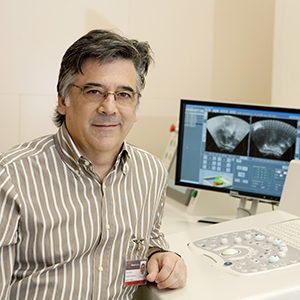Focused ultrasound (FUS) is a potentially safe and effective treatment modality and may increase survival in unresectable pancreatic cancer, according to a study recently published in Ultrasonics Sonochemistry.
 In “Ultrasound Guided HIFU for malignant tumors: The Spanish experience of survival advantage in stage III and IV pancreatic cancer,” Dr. Joan Vidal-Jove and his Barcelona group treated 43 unresectable malignant pancreatic tumors (29 stage III and 14 stage IV) with ultrasound-guided FUS ablation in combination with adjuvant chemotherapy from March 2010 to December 2013.
In “Ultrasound Guided HIFU for malignant tumors: The Spanish experience of survival advantage in stage III and IV pancreatic cancer,” Dr. Joan Vidal-Jove and his Barcelona group treated 43 unresectable malignant pancreatic tumors (29 stage III and 14 stage IV) with ultrasound-guided FUS ablation in combination with adjuvant chemotherapy from March 2010 to December 2013.
Ablation was achieved in 82% of the tumors, with the responses lasting 8 weeks post-procedure. At the end of the combined treatment, 11 patients (25%) had complete responses (9 Stage III and 2 Stage IV). Major complications included one case of severe pancreatitis with GI bleeding and two cases of third degree skin burns that required plastic surgery. The median survival was 13 months (6 months to 2.7 years). The Kaplan-Meier curve showed 33.5% survival for 4.2 years in patients treated with FUS plus chemotherapy.
“We are very satisfied with these results,” said Dr. Vidal-Jove. “The work of our team proves that focused ultrasound helps patients with unresectable pancreatic cancer, improving their survival with a less aggressive approach. We are planning a multicenter study comparing standard treatment with chemotherapy versus focused ultrasound plus chemotherapy in this group of patients.”
The Spanish study compliments and validates Japanese research published last year in World Journal of Gastroenterology. From 2008 through 2011, Dr. Atsushi Sofuni and his group at Tokyo Medical University treated 30 patients with pancreatic cancer (16 Stage III and 14 Stage IV) with ultrasound-guided FUS and chemotherapy. They found a 66.7% rate of symptom relief: 4 patients had a partial response, 22 patients had disease stabilization, and 4 patients experienced disease progression. No severe adverse events occurred in this study, but 2 patients suffered from pseudocyst formation and 1 patient developed mild pancreatitis. They concluded that the treatment was safe and a potential combination treatment method for this disease.
For several years, studies from China have also demonstrated the feasibility of ultrasound-guided HIFU to treat pancreatic cancer. Comparative studies have demonstrated the efficacy of HIFU for palliation of pain and some studies have even shown a modest survival benefit, which was recently confirmed in a systematic review. However, the evidence is still considered to be of poor quality, limiting the interpretation of these results.
“These two papers from large medical centers outside of China further demonstrate the feasibility of treating advanced pancreatic cancer with focused ultrasound. The treatment appears to be safe, with some expected adverse events. Although the Spanish paper suggests a possible survival benefit, a comparative study is necessary to further evaluate this outcome,” said Joo Ha Hang, MD, PhD, Section Chief of Gastroenterology at Harborview Medical Center, University of Washington, Seattle.
In addition to the ultrasound-guided FUS studies that have been published, MR-guided FUS is also being used to treat pancreatic cancer. MR-guided FUS has the advantage of being able to monitor the ablation with near real-time thermometry, which is a limitation of current ultrasound-guided FUS systems.
The Focused Ultrasound Foundation has funded pre-clinical research on the use of MR-guided FUS for hyperthermia enhanced targeted drug delivery with temperature sensitive liposomes to treat pancreatic cancer, which has led to additional NIH funding.
